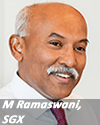The Singapore Exchange (SGX) has plans to make further executive-level hires, but stresses that future growth will be organic.
“We might add someone in commodities and may launch some FX products later this year and will need to build our strengths there,” said Muthukrishnan ‘Ramu’ Ramaswami, president of SGX.
“We’re opportunistic hirers so there are no constraints in what type of person we can hire. We can look to bring experienced people in from the industry – we’re not in any rush and it will be a steady build up.”
In June, SGX appointed Nico Torchetti as post-trade services head as it expanded its post-trade business, including building SGX’s Central Depositary. The exchange is now conducting a similar technological push on the post-trade environment for securities that it has done for derivatives.
In April, Jenny Chiam joined SGX from Nomura as head of securities in order to drive the exchange’s equities business. She replaced Nels Friets, who will soon retire.
The exchange president admits that SGX does not have the scale that some of the western exchanges have. He feels that the challenge is to grow by building scale and being competitively globally.
“If it was just a matter of building resources we could buy a western exchange,” said Ramaswami. “That’s not our game in the sense that we’re not just looking for scale for its own sake, but we want to be the best provider within Asia. We have to grow scale by accelerating market development, not just increasing our own size.”
Such an organic approach to growth was not the philosophy of Hong Kong Exchange and Clearing, which ventured to Europe and bought the London Metals Exchange.
“Hong Kong has gone the inorganic way of building size,” he said. “It will be interesting to see how that works in the next two to three years. However, insofar as the London Metals Exchange is concerned, I’m not ashamed to say we couldn’t have afforded the price they paid.”
SGX is positioning itself as a gateway to Asia, incorporating ASEAN countries and India, whereas it sees Hong Kong’s edge the links to China.
SGX has been spending S$30 million to S$40 million per year to pay for its technological development for the last five years and plans to maintain that figure going forward. The exchange is now at a steady state of cashflow on what they spend on technology, with new investment matching depreciation.
Five years ago, SGX built a new derivatives infrastructure and trading engine and Ramaswami says that is why their derivatives business has grown at the rate that it has grown.
SGX reported this week its total futures and options volume increased 52% year-on-year to 8.8 million contracts. In that period SGX’s China A50 Index Futures volume more than doubled to 1.7 million contracts.
